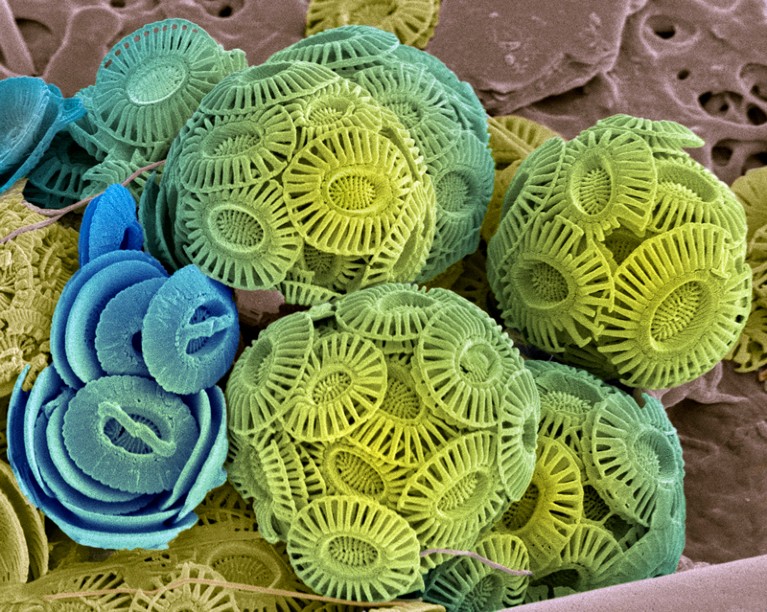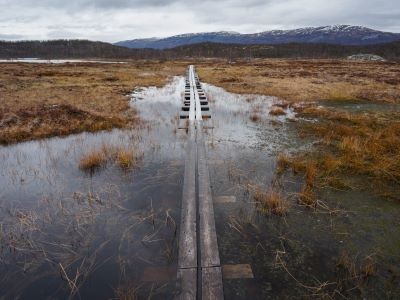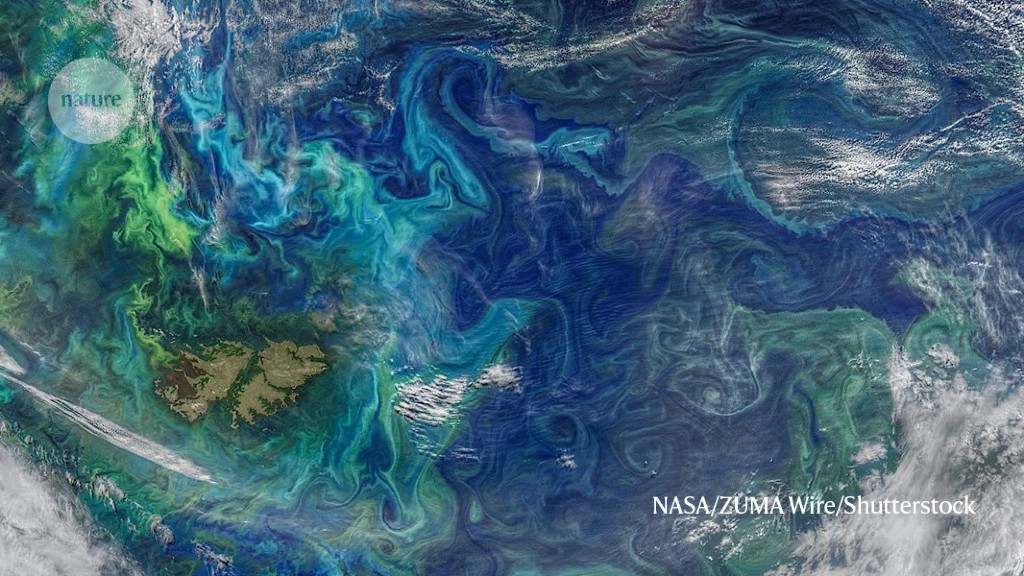Marine microorganisms are crucial for ocean health. Bacteria, archaea, fungi, algae and viruses make up most of the biomass in the seas and form the base of marine food webs. They support nutrient cycling and drive crucial biogeochemical processes, including key steps in the carbon, nitrogen and silicon cycles.
But the climate crisis is putting stress on oceans through steadily rising temperatures, longer and more frequent heatwaves, acidification and changes in nutrient levels. Understanding how marine microbes are affected is key to forecasting the future state of the oceans, and mitigating the effects of the crisis on marine ecosystems as well as the human communities that rely on them for livelihoods and food.
Ocean forecasting isn’t easy. Oceans are hugely complex systems, and forecasters need to incorporate an array of changes in ocean physics (waves, currents and interactions with the atmosphere), biology (how organisms react to the environment, as well as with one another) and chemistry (different forms of essential elements and their sensitivity to oxygen or pH). These models must cover a range of scales, from national waters to expanses of open ocean. They must also be able to simulate extreme states, such as marine heatwaves, and conduct simulations over hundreds of years.
Presently, there is little confidence in, or even consensus on, predictions of how marine microbes will react to changes in the climate. Researchers in marine microbiology, physiology, biogeochemistry and modelling must join forces to better observe, understand and, ultimately, model microbial processes. Here, I outline some priority areas.
Limitations of present models
Ocean models have expanded in their scope over the years. Originally, they were built to represent physical processes, such as large-scale circulation and the transport of heat and salt. In the 1980s and 1990s, simple versions of the carbon cycle were added. Since the 2000s, scientists have accounted for the role of phytoplankton in the cycling of carbon and other nutrients, through processes such as photosynthesis, nutrient limitation (in which growth is limited by the scarcity of an essential element, such as nitrogen or iron) and predation. Phytoplankton at the base of the food chain perform roughly half of the photosynthesis that occurs on Earth. The organisms’ impact can be assessed using the oceanic concentration of the photosynthetic pigment chlorophyll, which can be determined by satellite observation.
For reasons of computational efficiency, however, only a subset of key groups was modelled. This includes bloom-forming diatoms; small phytoplankton, such as Prochlorococcus and Synechococcus, that dominate nutrient-poor regions of the ocean; cyanobacterial diazotrophs that fix nitrogen by converting inert dinitrogen (N2) into the more useful ammonia (NH3); and coccolithophorids that produce shells of calcium carbonate (CaCO3).
Researchers maintain plankton nets for use in the Chukchi Sea, between Alaska and Siberia.Credit: AB Forces News Collection/Alamy
These groups were accounted for using simple mathematical representations of the factors regulating their biomass, such as growth and predation rates. And the groups are assumed to follow the ‘law of the minimum’, according to which the least abundant resource is what limits growth rates; the impact of fluctuations in the levels of other essential resources is not included.
In recent years, such biogeochemical models, together with observation-based estimates, have become an integral part of efforts to assess fluxes of anthropogenic carbon accumulated in the ocean. Yet it remains challenging to predict changes in crucial biological fluxes with similar confidence. For example, it is not known whether the rate at which the biomass is generated by phytoplankton will increase or decrease under various climate-change scenarios1.
Such gaps in knowledge hinder scientists’ ability to understand, manage and mitigate impacts of the climate crisis on ocean health and the marine food supply2. The poor understanding of projected changes at the base of the food chain has huge implications for modelling and forecasting at all levels, including in Earth and environmental sciences, as well as for the global economy.
Bridge biological data and ocean modelling
In the past decade, technological advances have revolutionized scientists’ ability to observe and monitor oceanic biological processes across time and space. Satellite data are being used to assess ocean ecology through changes in the oceans’ optical properties, and autonomous robots are profiling the oceans, revealing variations in nutrient and chlorophyll concentrations.
In parallel, the explosion of ‘omics’ approaches — such as genomics, transcriptomics, proteomics and metabolomics — has brought about a molecular-level understanding of the complex functioning of marine microbes. These methods can help to illuminate the role of complex networks of interacting organisms3, and estimate how open-ocean communities can respond to future environmental changes4.

A darkfield microscope image of marine phytoplankton.
Emerging work that uses ocean biogeochemical, omic and remote-sensing data has revealed shortcomings in the current generation of ocean models. Notably, these models cannot reproduce resource stress or phytoplankton growth dynamics (in terms of either trends or variability)5–7. Resources that had previously been ignored by models, such as manganese, zinc and B vitamins5, are now known to influence phytoplankton growth and physiology8.
Furthermore, the law of the minimum seems to be an oversimplification. Earlier this year, a large-scale synthesis effort found that control by more than one resource (for example, iron and nitrogen) is relatively widespread8. Various ‘co-limitation’ scenarios exist in which two or more nutrients can limit growth, either independently of each other or not. This interconnectedness is corroborated by findings derived from proteomics, which suggest that marine microbes frequently experience scarcity in multiple resources at once5,9.
Genomic techniques are now routinely deployed during research voyages and ocean surveys. Yet the data they generate remain largely unexploited by the ocean biogeochemical models used for climate-change studies, which focus instead on representing bulk biological or biogeochemical indicators (such as the concentration of nutrients or chlorophyll).
Time to remodel
Researchers should now come together to embed biological information and insight into biogeochemical models. Several issues must be addressed to reduce uncertainties in the response of ocean microbes to global change. Some pertain to the scope for organisms to adapt, the importance of functional and biological diversity and whether specific groups of organisms that perform key biogeochemical functions are affected differently. The manner in which scientists detect and attribute change in microbial and biogeochemical systems is also crucial. Finally, researchers must explore the importance of biologically mediated feedbacks on the environment (such as whether cycling of compounds that are relevant to climate or biogeochemistry is affected by microbial activity); the role and size of any feedbacks from ocean-based efforts to remove carbon dioxide; and the sustainability of vital processes such as nitrogen fixation or calcium carbonate production.

A scanning electron microscope image of marine coccolithophores, showing their external structures made of calcium carbonate.Credit: Steve Gschmeissner/SPL
The following three approaches to this challenge are being deployed, but remain limited.
Extending biogeochemical models. Incorporating further sets of organisms10 or growth-limiting resources11 in models can allow large-scale testing of whether these extra layers of detail affect results. But the utility of this approach is limited by its sheer complexity. Even the most elaborate current model would struggle to accommodate parameters that adequately represent microbial biodiversity and take into account phenomena such as co-limitation and how species respond to a changing environment, because simulations must be carried out at the global scale and over the long term.
Exploiting statistics. Statistical techniques can forecast the changes expected for a given species or ecological group as a function of well-measured predictors (such as sea surface temperature). These approaches use environmental conditions from ocean biogeochemical models or large-scale data sets to build statistical relationships with detailed biological data on organism abundance or interaction networks, for example.
Such techniques are widely used to infer how environmental changes affect the distribution of key organisms (such as plankton communities)12, and are sensitive to the density of observations. However, important biomes can be missed in some regions owing to insufficient sampling, and statistical methods don’t account for any changes in the link between the species of interest and possible future ocean conditions. Such issues have led to opposing predictions, for instance, of how the abundance of Prochlorococcus could change over time13.
Using mechanistic metabolic modelling. Models based on microbial metabolisms revealed by genomic techniques can be coupled with environmental data from observations or ocean biogeochemical models. Such mechanistic metabolic models have the most potential in the longer term. Some have been used to explore co-limitation involving iron and manganese14 and how the cellular physiology of various strains of Prochlorococcus is connected to their large-scale distribution15. Ultimately, one could imagine a direct coupling of mechanistic metabolic models with ocean biogeochemical models to enable a dynamic two-way interaction between environmental change and ocean microbial health.
Modelling tools that embrace aspects of all three approaches are needed to address the impacts of global change on marine biological systems. For instance, a combination of mechanistic metabolic models and statistical approaches could simplify the representation of key cellular processes, which could then be parameterized for key phytoplankton groups that extend existing global ocean biogeochemical models.
Alternatively, it could be that the entire biological component of the current generation of ocean biogeochemical models will be replaced by a statistical approach. This would be informed by an underlying metabolic or genome-based model that focuses solely on how key biogeochemical fluxes (for example, nutrient cycling, oxygen production or the amount of biomass generated by phytoplankton) are related to changing environmental conditions.
More ambitiously, greater fundamental understanding and parallel developments in mathematical and ecological theory could harness growing computing power. This would facilitate the modelling of microbial molecular biology, biodiversity and biogeochemical cycles from a mechanistic standpoint in global ocean models, reducing uncertainties in forecasts by increasing realism.
Next steps
Over the next 10–20 years, funders must substantially invest in interdisciplinary science so that tools to explore global impacts on microbial ecosystems can be developed.

How microbes in permafrost could trigger a massive carbon bomb
International collaborations will be needed. Scientists working in molecular biology, microbiology and biogeochemical oceanography are already linking worldwide efforts through a programme called BioGeoSCAPES.
An important focus is the training of a new generation of scientists who can operate across disciplines. This is under way through the formation of a cohort of early-career BioGeoSCAPES fellows.
The development of interoperable data sets based on common data and a pipeline that feeds new understanding into improved predictive models is crucial if scientists are to transition to a more coherent, joined-up international effort to better constrain the impacts of climate change. Ultimately, these efforts must be designed to feed into assessment activities overseen by groups sponsored by the United Nations, such as the Intergovernmental Panel on Climate Change and the Intergovernmental Science-Policy Platform on Biodiversity and Ecosystem Services.
Model projections that account for marine microbial processes with better accuracy and greater confidence are crucial to climate forecasts. They can be achieved only by breaking down disciplinary silos.

Dr. Thomas Hughes is a UK-based scientist and science communicator who makes complex topics accessible to readers. His articles explore breakthroughs in various scientific disciplines, from space exploration to cutting-edge research.








